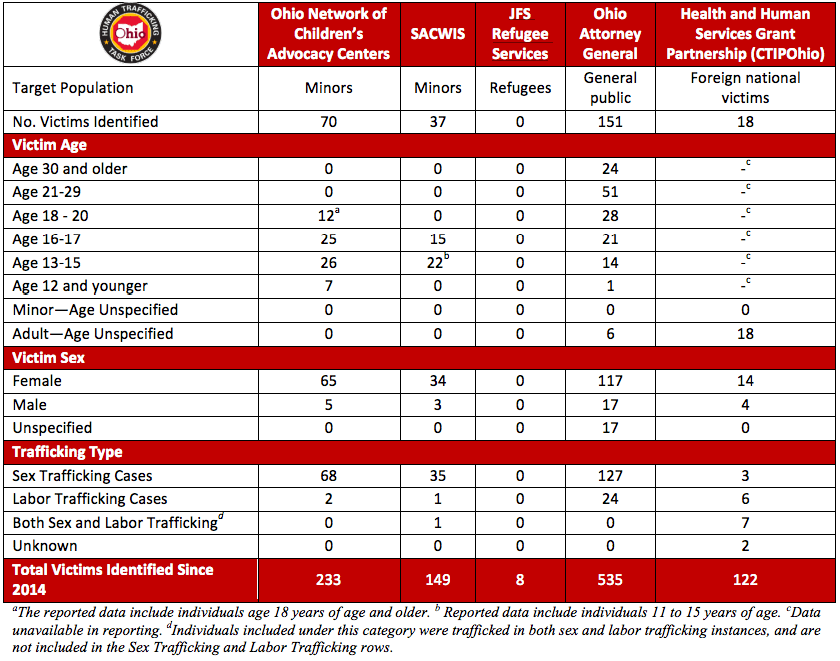
Ohio Human Trafficking Data from State Sources 2016
- Sex trafficking in which a commercial sex act is induced by force, fraud, or coercion, or in which the person induced to perform such an act has not attained 18 years of age.
- The recruitment, harboring, transportation, provision, or obtaining of a person for labor or services, through the use of force, fraud, coercion for the purpose of subjection to involuntary servitude, peonage, debt bondage, or slavery.
In 2012, Ohio passed legislation guiding the identification of victims of trafficking in persons and guiding the prosecution of traffickers and purchasers of commercial sex from minors. The table below provides summary data on those cases from Ohio’s agencies and partners.

State Data Sources:
The Ohio Network of Child Advocacy Centers (ONCAC) provides support, education, and networking opportunities to enhance Ohio’s response to child abuse, including minors who are victims of human trafficking. Within a children’s advocacy center, agencies and professionals work together to reduce the trauma young victims experience and to enhance the system’s ability to respond to child maltreatment. Through a grant partnership with the Governor’s Ohio Human Trafficking Task Force and the Ohio Department of Job and Family Services, ONCAC began reporting identified cases of human trafficking in July 2013. The data are reported quarterly to meet state and federal grant requirements. Since the grant partnership began in July of 2013, 262 victims of human trafficking have been identified by Ohio’s children advocacy centers. In 2016, ONCAC reported the identification of 70 victims of human trafficking.
The Statewide Automated Child Welfare Information System (SACWIS) is the case management system utilized by the Ohio Department of Job and Family Services, along with 88 county public children services agencies, to assist staff in managing workloads and provide current data. Human trafficking reporting was integrated into the system in November 2013. In 2016, 37 records of human trafficking were identified, as reported by the Ohio Department of Job and Family Services.
The Ohio Department of Job and Family Services – Refugee Services Section (ODJFS Refugee Services) operates as part of a national and international effort to assist people displaced from their countries. The Refugee Services Section also serves victims of human trafficking certified by the U.S. Department of Health and Human Services, with reporting beginning in 2008. In 2016, ODJFS Refugee Services did not serve any victims of human trafficking.
The Ohio Attorney General’s Office collects data from local law enforcement related to human trafficking investigations, arrests, prosecutions, and convictions of traffickers. As required by Ohio’s “Safe Harbor” Law enacted in 2012, law enforcement must report the number of human trafficking cases identified annually to the Ohio Attorney General’s office (ORC 109.66). In 2016, local law enforcement identified 151 (potential and confirmed) victims of human trafficking.
The Combating Trafficking in Persons in Ohio (CTIPOhio) grant program, funded by the U.S. Department of Health and Human Services, provides assistance to foreign national victims of human trafficking in Ohio. Through a grant partnership with the Office of Criminal Justice Services, The Salvation Army of Central Ohio/Central Ohio Rescue and Restore Coalition, The Salvation Army of Greater Cincinnati/End Slavery Cincinnati, and Lutheran Social Services/Lucas County Human Trafficking Coalition, and additional outreach partners, the program identified 18 victims in 2016.
Data Limitations –
Ohio has made notable progress in data collection efforts since HB 262 passed in 2012. However, given the relative newness of state laws (and awareness of the federal law) and well-documented complexities resulting in underreporting and identification of trafficking victims, there is much work to be done in reliably determining the prevalence of the crime both in Ohio and the United States. The data compiled in the table is the first step in creating a statewide overview of the number of victims identified and referred for services in local communities. It is critical to note that the numbers reported in Table 1 should not be aggregated across different sources as there are likely instances in which a single individual is being served by multiple agencies.
